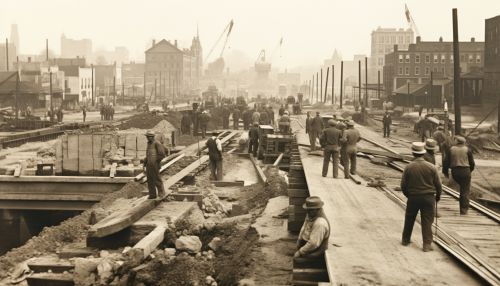New Deal
Introduction
The New Deal was a series of programs, public work projects, financial reforms, and regulations enacted by President Franklin D. Roosevelt in the United States between 1933 and 1939. It responded to needs for relief, reform, and recovery from the Great Depression. Major federal programs and agencies included the Civilian Conservation Corps (CCC), the Civil Works Administration (CWA), the Farm Security Administration (FSA), the National Industrial Recovery Act of 1933 (NIRA) and the Social Security Administration (SSA). They provided support for farmers, the unemployed, youth and the elderly. The New Deal included new constraints and safeguards on the banking industry and efforts to re-inflate the economy after prices had fallen sharply.


Origins
The term "New Deal" was coined during Franklin Roosevelt’s 1932 Democratic presidential nomination acceptance speech, when he said, "I pledge you, I pledge myself, to a new deal for the American people." Roosevelt summarized the New Deal as a "use of the authority of government as an organized form of self-help for all classes and groups and sections of our country."
Programs and Policies
The programs and policies implemented during the New Deal transformed American society and the nation's economic structure. They aimed to provide relief for the unemployed and poor, recovery of the economy to normal levels, and reform of the financial system to prevent a repeat depression.
Relief
Relief was the immediate effort to help the one-third of the population that was hardest hit by the depression. Roosevelt expanded Hoover's FERA work relief program, and added the Civilian Conservation Corps (CCC), Public Works Administration (PWA), and starting in 1935, the Works Progress Administration (WPA). In 1935 the Social Security Act (SSA) and unemployment insurance programs were added. Separate programs were set up for relief in rural areas, such as the Resettlement Administration and Farm Security Administration.
Recovery
Recovery was the goal of restoring the economy to pre-Depression levels. It involved "pump priming" (temporary fiscal stimulus), dropping the gold standard, and efforts to increase farm prices and foreign trade by lowering tariffs. There were also direct relief programs, such as the Reconstruction Finance Corporation (RFC), which Roosevelt expanded.
Reform
Reform was based on the assumption that the depression was caused by the inherent instability of the market and that government intervention was necessary to rationalize and stabilize the economy, and to balance the interests of farmers, business and labor. Reform measures included the National Industrial Recovery Act (NIRA), regulation of Wall Street by the Securities and Exchange Commission (SEC), new controls over banks and public utilities, and an enormous work relief program for the unemployed.
Impact and Legacy
The New Deal produced a political realignment, making the Democratic Party the majority (as well as the party that held the White House for seven out of the nine presidential terms from 1933 to 1969) with its base in liberal ideas, the South, traditional Democrats, big city machines, and the newly empowered labor unions and ethnic minorities. The Republicans were split, with conservatives opposing the entire New Deal as hostile to business and economic growth, and liberals in support. The realignment crystallized into the New Deal Coalition that dominated most American elections into the 1960s, while the opposition Conservative Coalition largely controlled Congress from 1937 to 1963.
The New Deal regulation of banking (Glass–Steagall Act) lasted until it was suspended in the 1990s. Along with the Wagner Act, which increased labor union power, the Social Security Act established a permanent system of universal retirement pensions (Social Security), unemployment insurance, and welfare benefits for the handicapped and needy children in families without a father present. The Fair Labor Standards Act of 1938 set maximum hours and minimum wages for most categories of workers.
Criticism and Controversy
The New Deal has been the subject of much debate, with critics arguing that it did not do enough to address the economic crisis, while others argue that it went too far in its intervention in the economy. Some critics argue that the New Deal was ineffective in ending the Great Depression, and that it was World War II that ultimately revived the U.S. economy. Others argue that the New Deal's policies hindered economic growth and prolonged the depression.
